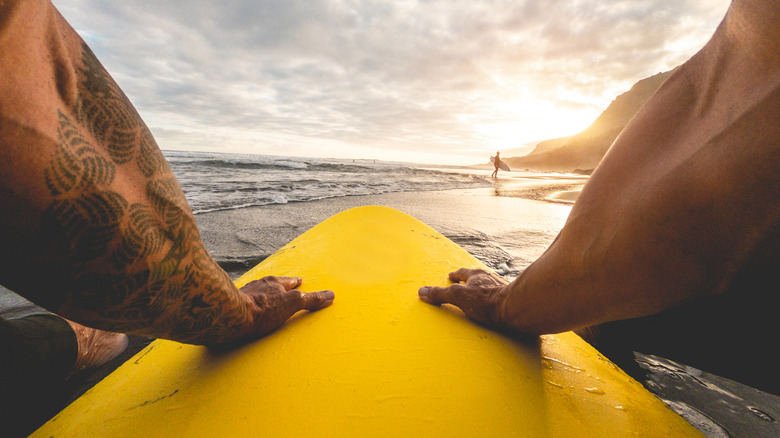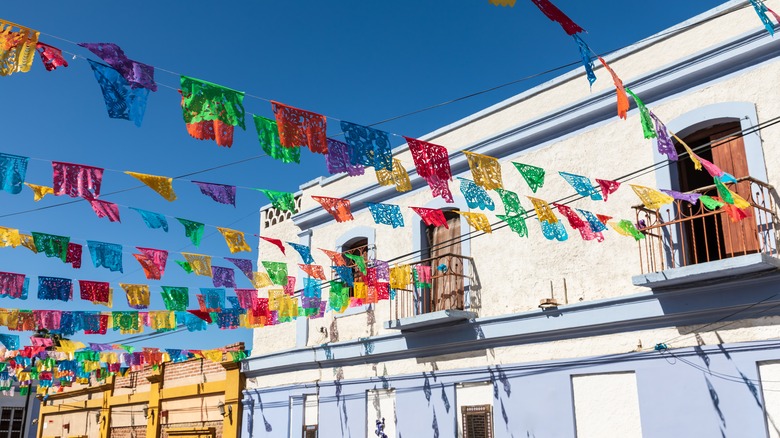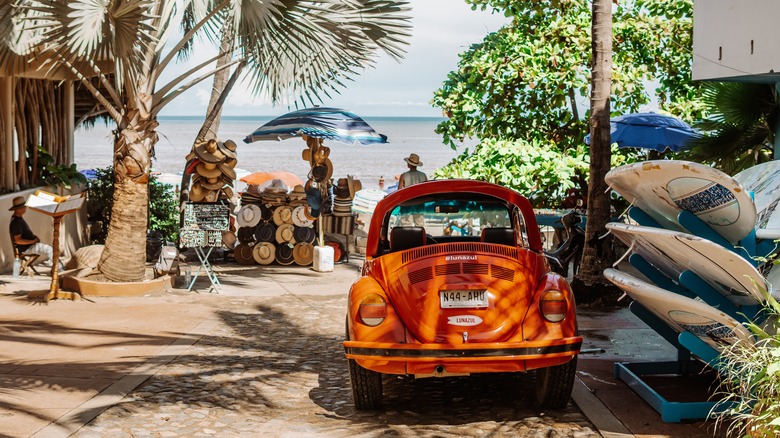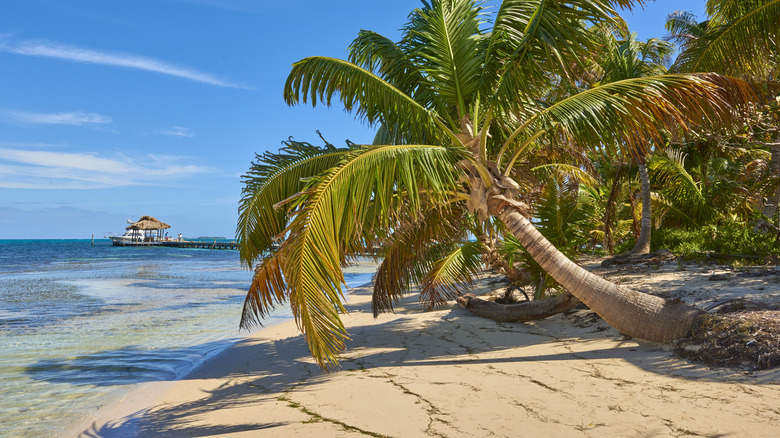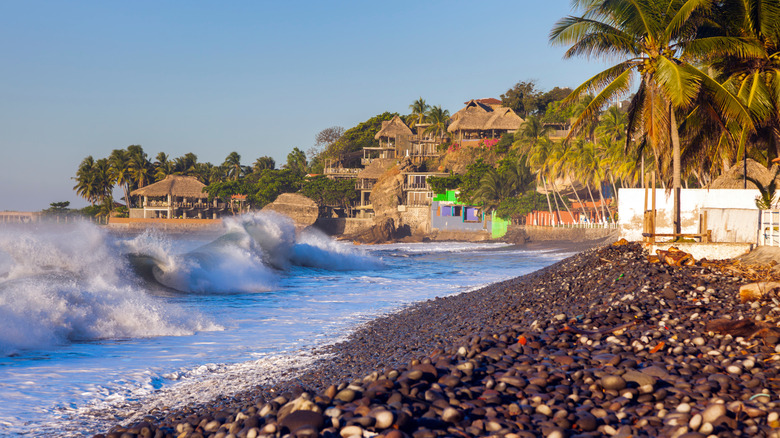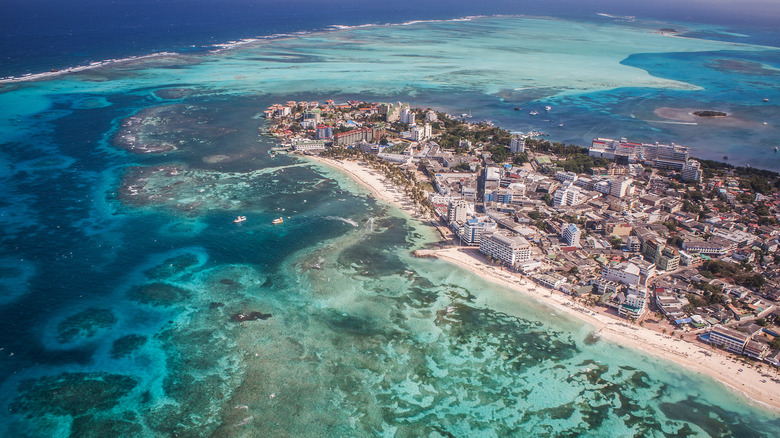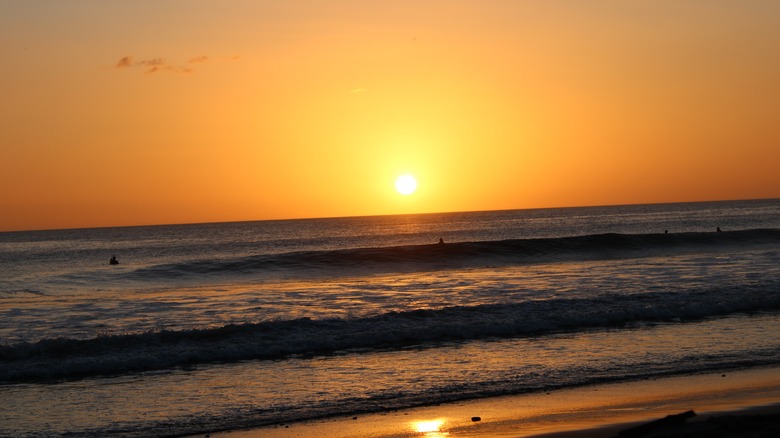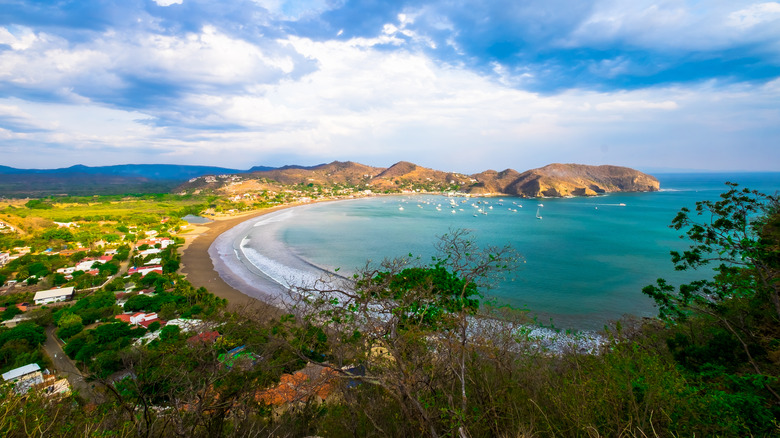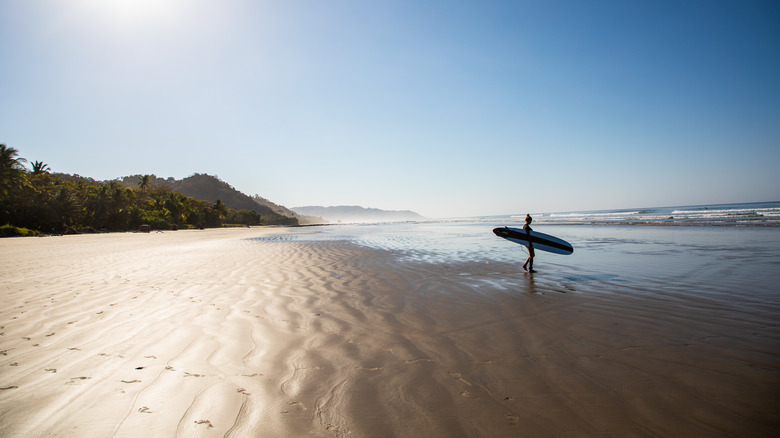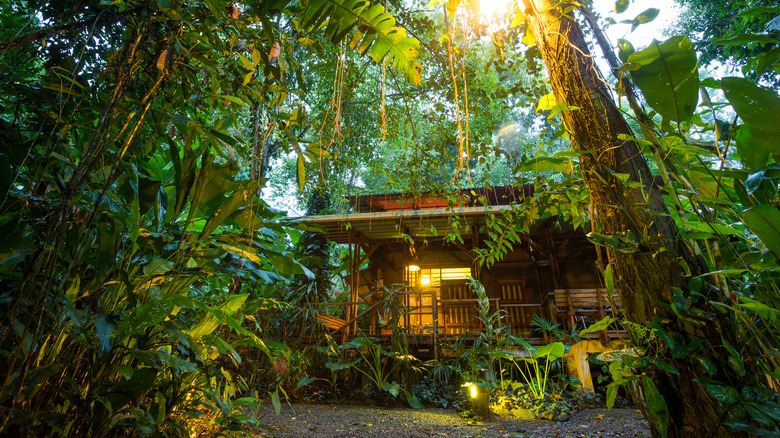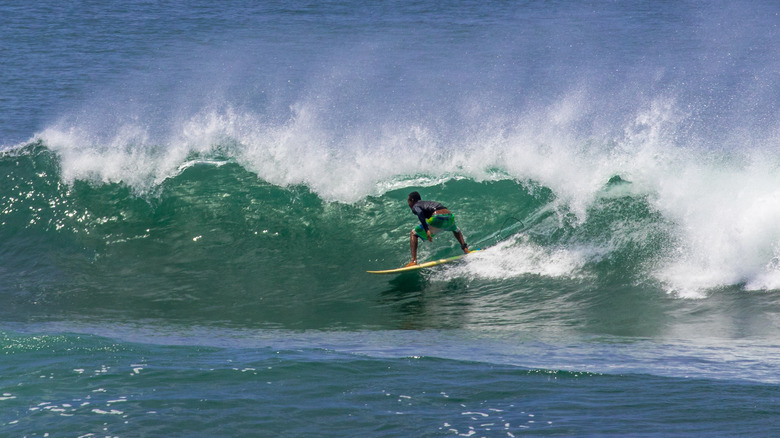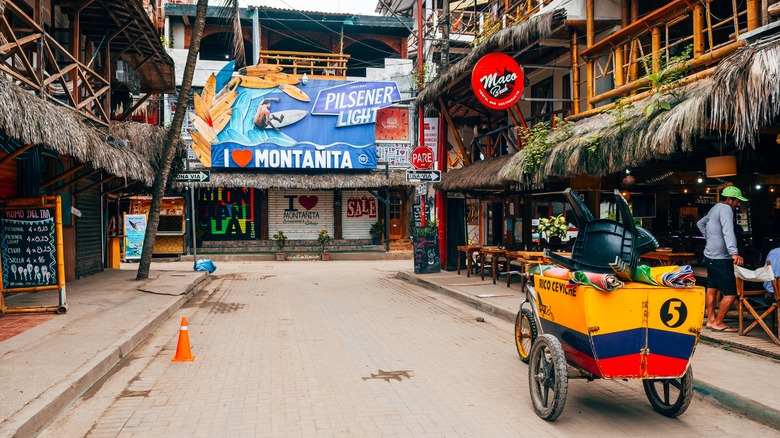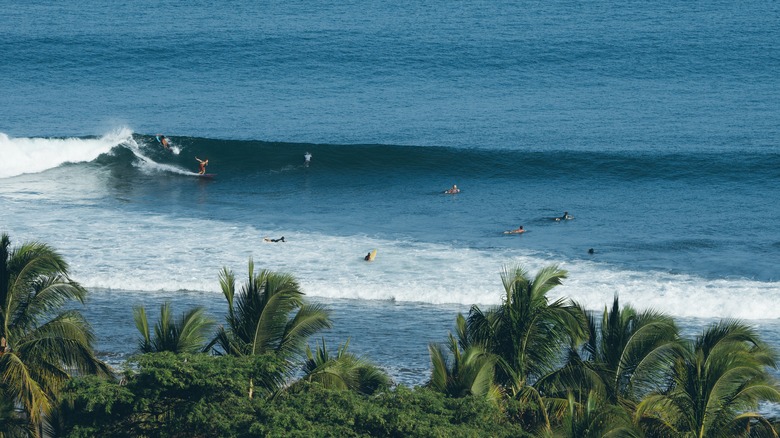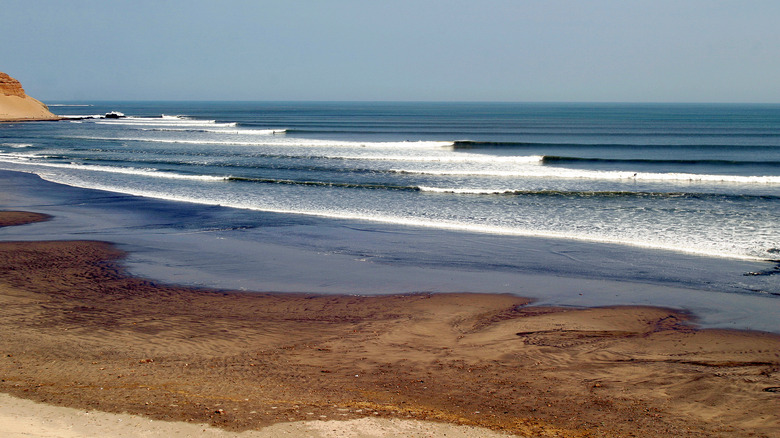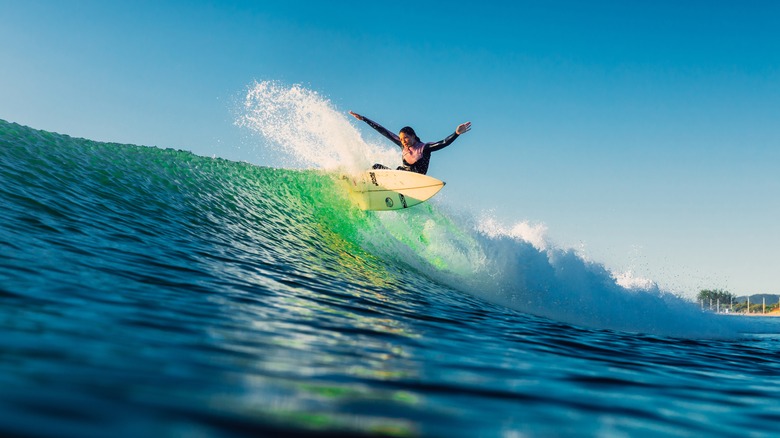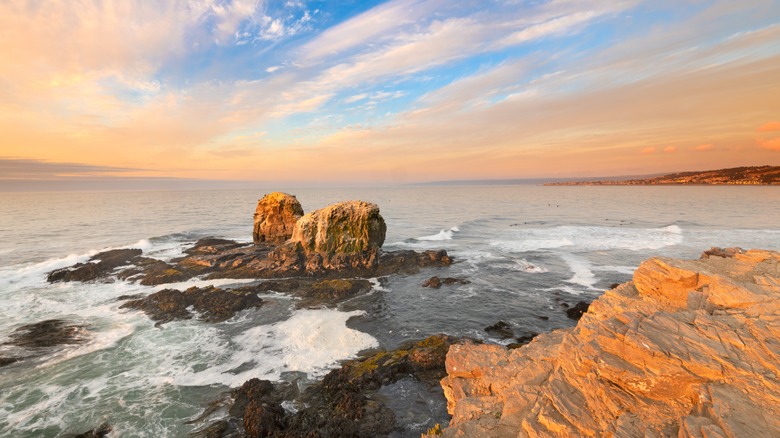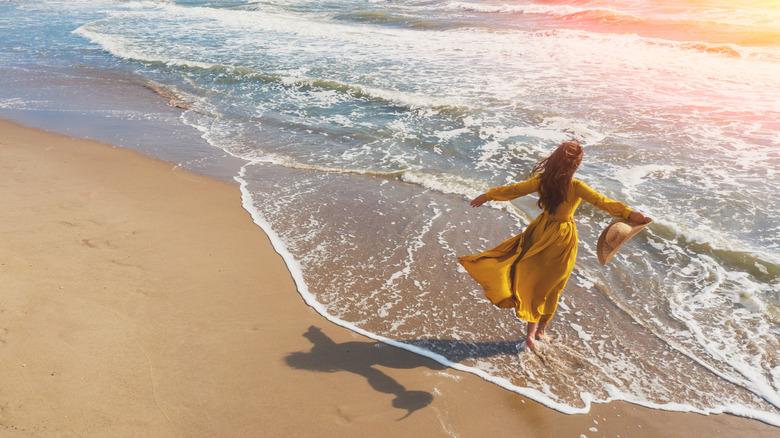The Best Surf Towns To Visit In Latin America
The group of countries that fall under the umbrella of Latin America — defined as Mexico, Central America, and South America — finds itself sandwiched between the pounding Atlantic and Pacific oceans. They are blessed with plenty of coastlines (the continent of South America alone has almost 16,000 miles of shore, according to Britannica), and are a haven for lovers of water sports. These nations promise a wide variety of places where adventurers can swim, dive, kayak, sail, waterski, and paddle board.
There's also some fabulous surfing, a sport that firmly hit the mainstream when it was introduced into the Summer Olympics for the first time at the 2020 Tokyo games. Interestingly, the men's event was won by Brazilian surfer Italo Ferreira, showing the world that surfing and South America are a winning combination. Residents of, and visitors to, this part of the world, boards tucked under their arms, can scout scores of places to perfect carving, snapping, and aerials, as the list below, working south shows.
Todos Santos, Mexico
When Todos Santos Bay was designated the first surfing reserve in Mexico in 2013, a classification awarded to it by Calfornia-based Save the Waves Coalition, the news received international media coverage, including a story in the Chicago Tribune. The precious surfing ecosystem, near the southern tip of Baja California, has a strong mix of manageable breaks in the water and closer to the shoreline, and a healthy dose of big waves, making the area attractive to surfers of all abilities.
Todos Santos town has a charming, small-town feel yet in the early 1700s it was commandeered by Jesuit missionaries (per Todos Santos.) Since then, its fortunes have fallen and risen, transforming it into a center of sugar-cane production, a colony for artists, and more recently a retreat for tourists and surfers. While less than 50 miles away from the vacationing nexus of Cabo San Lucas, Todos Santos has an entirely different ambiance, more boho-chic than luxury resort romping ground. Visitors can find plenty of places to stay, and eat, and even a good selection of art galleries here. For adventurers, surf schools and outfitters are easy to locate, while the waves are just waiting to be ridden.
Sayulita, Mexico
Sayulita Life serves primarily as a marketplace for vacation rentals (more than 650 hotels and private homes, all fee-free!) but it also has pages on the rich vein of activities in this pretty, cobblestone-street town an hour north of touristy Puerto Vallarta. You can learn more about the activities in Sayulita, including golf, horseback riding, diving, mountain biking, birding, fishing, and many beaches. You'll also learn about surfing here, which really gained traction in the 1960s and has steadily blossomed ever since.
Riders have plenty of options on waves to ride, with Surf Atlas identifying a number of surf spots in and around the town, graded by skill level (a number of them are suitable for beginners). Among the highlights of a trip here are the warm seas and the affordability of learning to surf, a boon for budget-conscious newbies to the sport that want to pick up a new skill but don't feel the urge, or need to splurge, for an entire vacation devoted to it.
Long Caye, Belize
Type 'Belize water sports' into a search engine and inevitably the first thing mentioned is scuba diving. That's not surprising; after all, this English-speaking Central American nation has barrier reef reserves that received UNESCO World Heritage status. The Great Blue Hole, an underwater sinkhole, spans 1,000 feet across and is the largest formation of its kind in the world (via Belize Tourism Board). And yet Belize does offer some good surfing, though it's only really found in one part of the country.
Long Caye is a mere slip of an island — confusingly there are many Long Caye's in Belizean waters, but this one is part of the Glover's Reef Atoll — with the usual snorkeling, diving, and fishing available through resorts like Off The Wall. What is less well known is that is a mild right-hand break that's dependable year-round, thanks to the reef; outfitter Slickrock Belize Adventures rents boards or take water babies out as part of an adventure package. While the surfing here isn't likely to give you the chills, it's a great alternative to the standard water sports roster of Belize.
El Tunco, El Salvador
The smallest country in Central America — and Latin America as a whole — El Salvador is about the size of Massachusetts (via National Geographic Kids). Its Lilliputian stature means getting around isn't as time-consuming as in other countries on this list. Located about an hour from the capital San Salvador, and about the same time from the country's international airport (per Google Maps), the seaside town of El Tunco has waves, barrels, and sizeable walls that the Reef Break blog declares make it a great option for surfers just starting out, or those that can shred on their board.
Conditions vary throughout the year, with the drier, calmer months November-April better suited to those new to the sport, while the more volatile rainy season, May-October, produces swells and waves, not for the meek. Accommodations here are rarely flashy, with the emphasis of a visit here firmly on the outdoors. Adventurers can learn how to surf with El Salvador Surf Camps, which has a school and lodging in town.
Punta Sur, Colombia
Colombia is where Central America encounters the continent of South America, but parts of the country are closer to the former than the latter. One such example is San Andrés, a Caribbean island due east of Nicaragua. Along with nearby isles Providencia and Santa Catalina, it makes up the UNESCO-designated site known as the Seaflower Biosphere Reserve. San Andrés showcases all the hallmarks of a classic, idyllic Caribbean getaway, with plenty of opportunities to snorkel, more than 40 dive sites, clear-blue-green water, and fine coral reefs (Per Colombia Tourism).
What's more, on the south of the island — hence the name — Punta Sur is a spot where Culture Trip notes that intermediate and advanced surfers will find solid waves (they vary in strength depending on the specific time of the year). Water sports enthusiasts can also get airborne above the aqua with kitesurfing — the island's conditions have also received high praise from Women Kiteboarding.
Popoyo, Nicaragua
Due south of the capital Managua, and not far from Lake Nicaragua (also known as Cocibolca, and according to Britannica, the largest lake in Central America), Popoyo is a quiet beach town with fabulous sunsets. It also receives consistent waves that Nicawaves Surf Resort believes make this part of the country a great destination for beginner and expert surfers alike. Of particular note, and an easy paddle from the town's beach, the Outer Reef is a slab or fast wave that rises dramatically almost from nowhere, which is perfect for advanced surfers.
Opened in 2008 by a pair of French surfers, and refurbished at the end of 2021, the resort Las Plumerias has a great breakdown of the different waves and breaks that draws surfers to Popoyo, including Mag Rock which is suitable for beginners. The property also offers surfing lessons, capping classes at a maximum of six pupils per instructor, and surfboards to rent for travelers that prefer to ride the waves solo.
Playa Maderas, Nicaragua
A short drive north of San Juan del Sur, a seaside hotspot in Nicaragua, Playa Maderas is an ideal place for beginners to get up and comfortable on their boards. That said, it doesn't have much tourist infrastructure, (via Along Dusty Roads), and travelers might find it more convenient to stay at San Juan del Sur, where accommodation, restaurants, and shops are plentiful. While surfing is the main draw on the water here, the beach is broad and sandy, and will certainly sate any sun worshippers that make the trip.
While you might have no interest in surfing, consider this: it's extremely easy and affordable to learn here. Buena Vista Surf Club has a lodge and cabañas tucked in between the trees and a large deck at the top of the property with views of the beach. It also provides surf lessons for $35 an hour, with a limit of three students per instructor, ensuring personal attention. Rapture Surf Camps, which runs programs on four different continents, has a resort and surf camp in Playa Maderas, and meals include vegetarian and vegan choices.
Santa Teresa, Costa Rica
Jutting out from the main body of Costa Rica like a bodybuilder's forearm, the verdant Nicoya Peninsula has a mountainous spine and plenty of stunning beaches lining its Pacific coast. More natural beauty exists at Barra Honda National Park, that My Costa Rica explains has a limestone cave network with more than 40 caverns, and signs that humans lived here more than 2,000 years ago. The peninsula is also an important turtle nesting site (via Costa Rica Experts), so visitors here have no shortage of options to keep them entertained.
Near the southern tip of Nicoya sits Santa Teresa, where the year-round waves and a handsome number of surf shops make this a magnet for wave riders. Surf Destinations lists a number of places to stay in town, together with approximate prices, and also discloses some of the best surfing spots here or close by. Right in town, the main beach is good for surfers with some solid know-how, while Suck Rock promises crisp right-hand breaks.
Puerto Viejo de Talamanca, Costa Rica
On a similar latitude as Santa Teresa, on the Caribbean Sea (but across the country), this town near the border with Panama is very laid-back and has water that's warm year-round, meaning surfers won't need to lug wetsuits around with them. In town, you can visit the Jaguar Rescue Center, which homes animals overlooked by society, either because they are ill or orphaned. Despite its name, many of its residents are monkeys and reptiles, and travelers that want a fuller experience can stay at the center's houses and bungalows (they have a hammock out front, great to unwind to the sounds of nature).
The town is also an epicenter of surfing, with Soul Rider Camp running teaching programs from Playa Cocles, close to all the choice spots. There are waves here for all skill levels, and newbies can try out the gentle rolls right in front of the camp.
Santa Catalina, Panama
Mention Panama, and most people will probably think of the canal — it's a pretty incredible piece of engineering, and watching those huge ships shuffle through it is an unforgettable, and often hot, experience — the hat (which is actually from Ecuador), and that the country uses the U.S. dollar for its currency (for more than a century, according to Panama Relocation Tours). Surfing might not be high on the list of things associated with the Central American country, but it's a huge draw to visitors to Santa Catalina.
This former fishing village on the Pacific has minimal tourism infrastructure, with limited places to stay or eat, but for those seeking some serious water power, the destination doesn't disappoint (via Visit Panamá). While surfers ride waves that can rise as high as a three-story house, onlookers can admire their daring from the town's black-sand beach. But beginners can also get in on the action, with schools like Waluua letting trainees ride gentler swells, guided by instructors with deep knowledge of the local aquatic realm.
Montañita, Ecuador
Despite its reputation as a great place to dance the night away every night of the week — with Go Backpacking arguing that Montañita is the pinnacle of party places in Ecuador — this town has more going for it than drinking, discos, and nightlife. Located less than three hours by car from the country's second-largest city, Guayaquil (via Google Maps), Montañita is also where surfers descend to shred. The town is relaxed and safe, the beach is broad and backed by forested hills, and the water conditions make it convenient for beginners.
Fitness website Salty Club explains how the beach break allows newbies to get comfortable with the conditions, while the point break La Punta (no awards for the originality of the name) will placate better surfers. Balsa Surf Camp supplies packages for visitors that want to combine a stay with some lessons on the water, and prices are a steal — starting at $740 for six nights of lodging, six surfing lessons, all meals, yoga classes, and more.
Máncora, Peru
The northern coast of Peru has a reputation for some fabulous surfing spots, and among them, this unassuming beach town has a large following in the Peruvian scene. Surf forecasting website Magic Seaweed observes that the water here has a left point break that is long enough to handle multiple wave riders at the same time. But this isn't the only spot to glide offshore. Wildkite Peru dispenses kiteboarding lessons but also has a surf camp in Máncora (it can also arrange your stay) that can get a newcomer up and riding, or hone the skills of surfers with water time under their wetsuits.
Beyond the break that the town is famous for, a range of other breaks entices thrill seekers, with colorful names like Panic Point and Peña Redonda (round rock). Surfers, however, aren't the only fast-moving bodies in the waters here. Every July through to October, humpback whales arrive having traveled here from Antarctica, giving birth in the Pacific. Adventurers can get close to these giant mammals, and hopefully spot their offspring, on boat tours with operators like Pacifico Adventures.
Chicama, Peru
Still in the northern part of Peru, but many hours south of Máncora, Chicama is spoken about in tones of awe by those in the surfing industry. News site Surfer Today proclaims that the left break here is the longest wave in the world, and allows surfers a ride that can last minutes. Optimal conditions are between April and October when winds produce consistent swells.
The actual wave makes landfall in the town of Puerto Malabrigo, some miles northwest of the actual, inland town that this wave is named for, but either way, visitors shouldn't expect any large town with thousands of options for accommodation, food, and entertainment. WB Surf Camps, based in the United States, offers seven-day camps to this northern Peru surf attraction, with lodging in a hotel complete with views of the iconic wave, two daily surfing sessions, a tuk-tuk tour of a desert, all meals, and airport transfers from and to Trujillo airport.
Florianóplis, Brazil
Santa Catarina Island sits off the east coast of Brazil and is home to Florianópolis, the capital of Santa Catarina state. The city, formerly known for its port, is now more popular as a holiday gateway to the beaches dotted around the island's coastline, and the fabulous surfing up and down the isle's east coast.
Floripa, as it's known, has terrific swells from the South Atlantic and even Antarctica, (per Wanna Surf), and consistent waves, especially during the periods between March and May and September and November. The site focuses on 21 specific surf spots, who they are good for, and the types of formations and directions of each, evidence that the island has an embarrassment of surfing riches. While Brazil might be lauded around the world for its football prowess (despite the 2022 World Cup quarter-final exit), Wavelength postulates that the country leads the global field when it comes to elite surfing. So expect to see plenty of talent out on the waters here.
Pichilemu, Chile
In this town, three hours by car from Santiago, breaks like La Puntilla are a good place for novices to get their bearings (via Go Chile). The geography here is stunning, with churning waters, rocky shores, and sheer cliffs that line the shore (via Chile Travel), and for surfers, the excitement doubles with the chance to ride 30-foot waves. The conditions are tiring, with cold water temperatures requiring wetsuits year-round, but even newbies can get wet and work up a sweat with surf instructors like Océanos Chile.
This is the location of Punta de Lobos, earmarked as a World Surfing Reserve by Save the Waves Coalition in 2017, a body of water that plays host to big-wave surfing competitions. Thrill seekers can also try their hand at windsurfing and kitesurfing here, while those more accustomed to leisurely strolls can wander around Ross Park, a national monument with century-old palm trees and a former casino (via Inspirock).
Mar del Plata, Argentina
The name of this city, located a five-hour drive or one-hour flight, from Buenos Aires (per Google Maps), translates to silver sea. That moniker is wholly appropriate since Mar del Plata's major claim to fame is as a summer beach retreat for residents of Argentina's capital. Sure it has a port and a strong fishing industry, but it's the strips of sand, and that glinting ocean, that really pulls in the money, and during high season, the beaches are packed with sun worshippers and water nymphs. That water is also where to find surfers, as the town is the heart of the surf scene in Argentina.
Low Pressure explains how the Roaring Forties (winds in the southern hemisphere), create swells that work their way up the Atlantic. Here, with jetties and piers breaking up the continuous flow of coastline, the swells meet resistance and breaks form. One of the finest breaks, according to Low Pressure, is La Pepita, while Playa Grande has regular, dependable waves. For travelers that want to experience the silver surf, Blueroad has trips based in Chapadmalal, just south of Mar del Plata.
